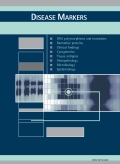Authors: Navarro-Hernández, Rosa
Elena | Oregon-Romero, Edith | Mercado, Mónica
Vázquez-Del | Rangel-Villalobos, Héctor | Palafox-Sánchez, Claudia
Azucena | Muñoz-Valle, José
Francisco
Article Type:
Research Article
Abstract:
To investigate the association of sICAM-1 and sVCAM-1 with ICAM1 721G>A and VCAM1 1238G>C polymorphisms and rheumatoid arthritis (RA) clinical activity, sixty RA patients and 60 healthy non-related subjects (HS) matched for age and sex were recruited. Soluble adhesion molecules were determined by ELISA technique. Rheumatoid factor (RF), C reactive protein (CRP) and the erythrocyte sedimentation rate (ESR) were measured by routine methods. Disability and clinical activity was measured with Spanish-HAQ-DI and DAS28
…scores, respectively. The ICAM1 and VCAM1 polymorphism were identified using the PCR-RFLP procedure. Inter-group comparison showed increased levels of sICAM-1 and sVCAM-1 in RA patients (284 and 481 ng/mL) versus HS (132 and 280 ng/mL); in the RA group, significant correlations between sVCAM-1 and RF (r = 0.402), ESR (r = 0.426), Spanish-HAQ-DI (r = 0.276), and DAS28 (r = 0.342) were found, whereas sICAM-1 only correlated with RF (r = 0.445). In RA patients, a significant association with the 721A allele of ICAM1 polymorphism (p = 0.04), was found. In addition, the allele impact (G/A+A/A) of this polymorphism was confirmed, (p = 0.038, OR = 2.3, C.I. 1.1–5.0). sVCAM-1 and sICAM-1 serum levels reflected the clinical status in RA, independently of the ICAM1 and VCAM1 polymorphism. However, the ICAM1 721A allele could be a genetic marker to RA susceptibility.
Show more
Keywords: Rheumatoid arthritis, polymorphism, soluble adhesion molecules, ICAM-1, VCAM-1
DOI: 10.3233/DMA-2009-0621
Citation: Disease Markers,
vol. 26, no. 3, pp. 119-126, 2009
Price: EUR 27.50





